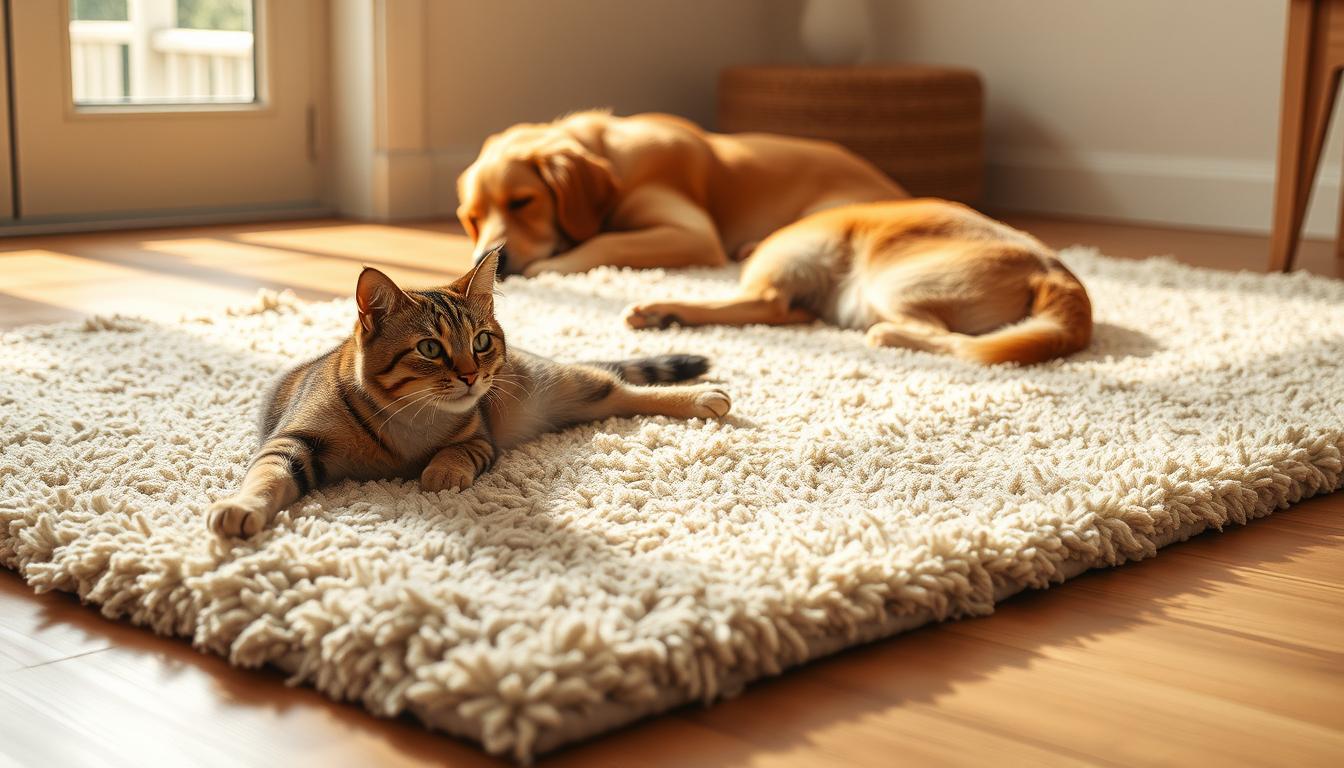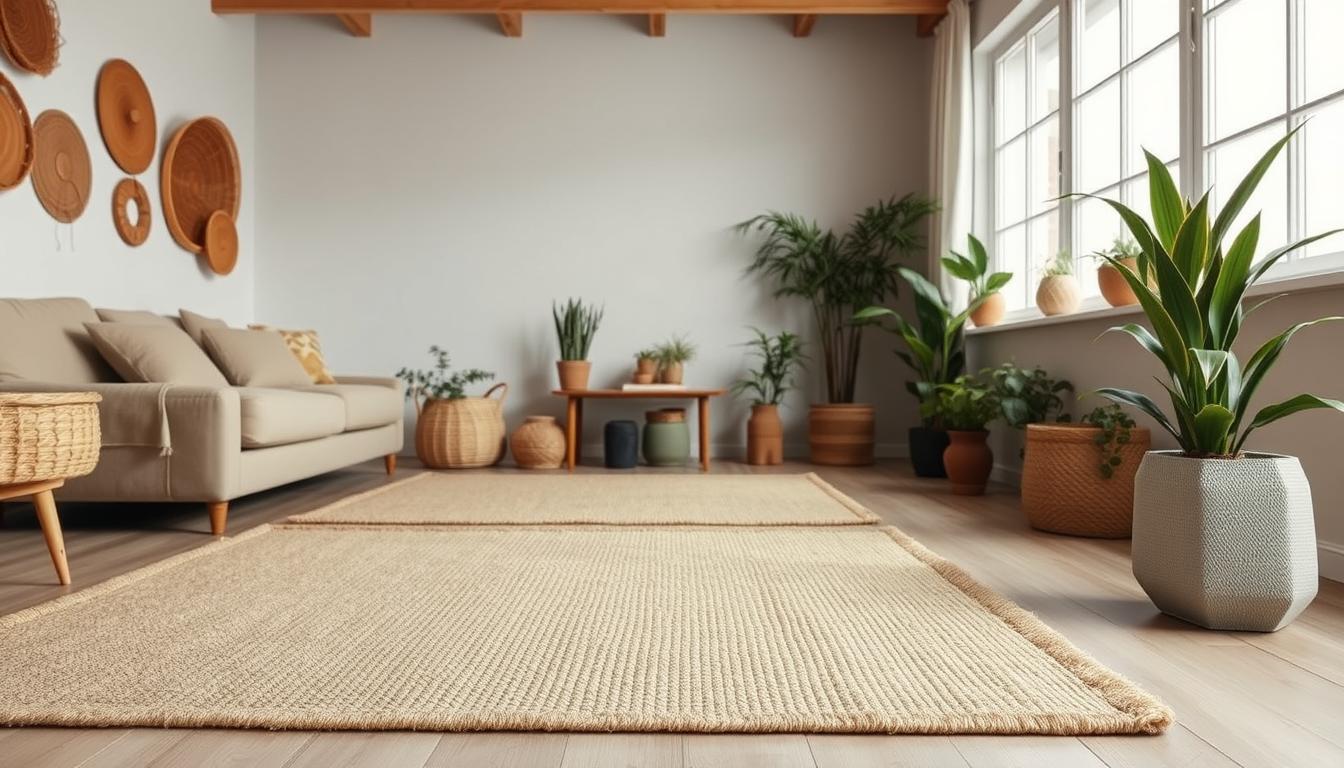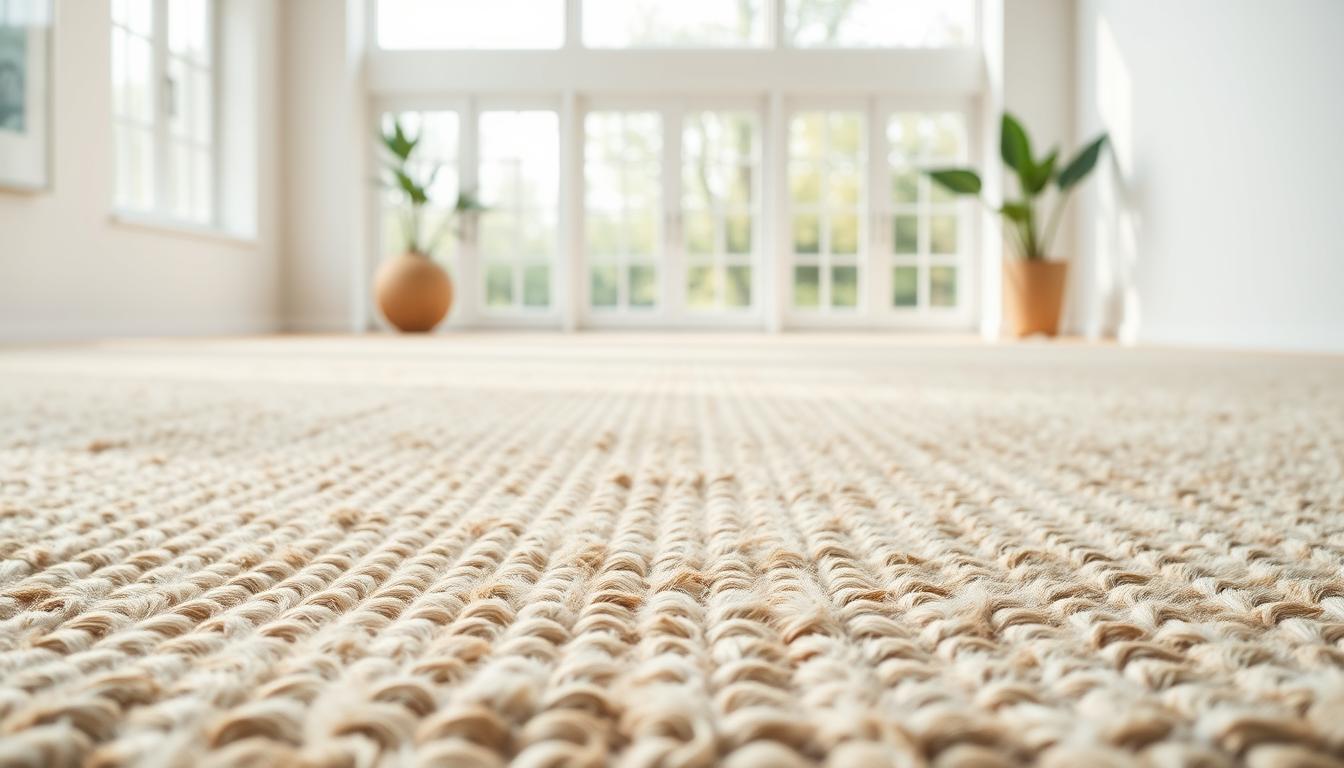
5 Honest Reasons Cotton Rugs Suit Pets
What if your flooring choice could harmonize comfort, cleanliness, and style in a home with furry friends? While durability often tops the checklist for pet owners, cotton rugs quietly deliver unexpected perks that might reshape your priorities.

Natural fibers like cotton create a cozy surface for naps or playtime. Their breathable texture stays gentle on paws, making them ideal for sensitive dogs. Many options are machine-washable, simplifying cleanup after muddy adventures or spills.
Affordability plays a key role, too. Unlike pricier materials, these floor coverings let you refresh your space without stress. Though heavy use may cause faster wear, their replaceable nature balances practicality with comfort.
Key Takeaways
- Natural softness supports joint health during play or rest
- Machine-washable designs simplify stain removal
- Budget-friendly replacements reduce long-term costs
- Breathable fabric resists odors common in pet areas
- Lightweight construction allows easy rearrangement
Introduction: Embracing Pet-Friendly Rug Solutions
Transforming your living space into a pet-friendly haven without sacrificing chic starts with rethinking floor decor. Modern rug materials now blend aesthetics with practicality, offering scratch-resistant surfaces that handle claws and muddy paws. Gone are the days when stylish interiors meant compromising on functionality for households with animals.
Designers now prioritize stain-resistant weaves and non-toxic dyes in pet-friendly floor coverings, ensuring safety during playtime. These options resist odor buildup while providing cushioning for naps—critical features traditional decor often overlooks. The shift toward durable, low-maintenance textiles reflects a broader trend in pet-owning households.
| Feature | Traditional Rugs | Pet-Friendly Options |
|---|---|---|
| Surface Texture | Delicate fibers | Reinforced weaves |
| Cleaning | Professional only | Machine-washable |
| Allergen Control | Traps dander | Hypoallergenic |
Smart selections balance vibrant patterns with practical benefits—like hiding fur between vacuum sessions. Expect materials that withstand daily adventures while complementing your color scheme. This approach lets you craft spaces where both design aspirations and pet needs thrive harmoniously.
Are Cotton rugs good for pets?
Natural fibers shine in homes with four-legged companions through their blend of softness and practicality. Gentle textures cushion joints during play, while breathable weaves maintain paw-friendly surfaces year-round.
Exploring Comfort and Safety Benefits
Your furry friend’s naps gain orthopedic support from cotton’s plush surface. Hypoallergenic properties reduce skin irritation risks, especially crucial for allergy-prone animals.
Machine-washable designs transform cleanup routines. Toss them in after muddy walks or accidents—no special treatments needed. This feature proves vital for households with puppies or senior pets requiring frequent washing.
Considerations for Durability and Stain Resistance
While cotton offers immediate comfort, heavy scratchers might test its limits. Synthetic blends typically withstand clawing better over time. For low-traffic zones like bedrooms, natural fibers excel at balancing coziness with care.
Stain visibility varies across weaves. Tightly constructed options mask spills better than loose knits. Rotate floor coverings seasonally to distribute wear patterns evenly across high-use areas.
Choosing the Right Rug Material For Pet Owners
Your flooring choice impacts daily life with animals more than you might expect. Materials determine how easily fur lifts during vacuuming, whether accidents leave permanent marks, and how long surfaces withstand claws. Let’s break down top contenders.
Cotton, Wool, and Synthetic Comparisons
Synthetic fibers dominate high-traffic zones. Polypropylene resists stains and odors better than most natural options—ideal for homes with puppies or senior pets. Polyester handles scratches well, while chenille blends add softness without sacrificing durability.
Wool offers natural stain resistance but absorbs liquids slower than synthetics. Over time, repeated accidents may cause discoloration. Its dense fibers trap fewer allergens than cotton, though professional cleaning often becomes necessary.
| Material | Durability | Stain Resistance | Maintenance |
|---|---|---|---|
| Polypropylene | High | Excellent | Machine-washable |
| Wool | Moderate | Good | Specialist cleaning |
| Polyester | High | Very Good | Spot treatment |
Color, Pattern, and Maintenance Factors
Busy patterns hide fur between cleanings better than solid hues. Darker tones mask minor stains but show light-colored pet hair more visibly. Low-pile weaves in synthetic materials simplify vacuuming compared to wool’s thicker texture.
Rotate floor coverings quarterly to distribute wear from favorite pet nap spots. Machine-washable options save time, while stain-treated polyester withstands repeated wash cycles without fading.
Rug Maintenance & Cleaning Tips Your Pet Will Love
Pet owners know accidents happen—here's how to handle them. Regular care preserves your floor coverings while creating a healthier space for play and relaxation. Start with vacuuming techniques that capture hair without damaging fibers.

Effective Vacuuming and Spot Treatment
Adjust your vacuum’s beater bar height and disable spinning brushes to protect delicate weaves. This setup lifts pet hair efficiently while preventing frayed edges. Aim for weekly sessions in high-traffic zones to control shedded fur and dirt accumulation.
For fresh stains, mix ½ cup hydrogen peroxide with dish soap—a non-toxic solution that attacks odors and bacteria. Blot spills immediately instead of rubbing to prevent deeper penetration. Always test homemade cleaners on hidden areas first.
Handling Urine, Vomit, and Dirt Quickly
Speed matters when tackling accidents. Blot liquids with absorbent cloths, then apply your cleaning mixture in circular motions. Rinse thoroughly to avoid residue that might attract more dirt.
Delayed response allows moisture to seep into fibers, often requiring professional intervention. For machine-washable options, use cold water and mild detergent to preserve colors. Rotate drying methods—air-drying prevents shrinkage, while low-heat cycles offer convenience.
Remember: consistent care reduces long-term wear. Quick fixes paired with routine deep cleaning keep surfaces fresh through years of paw traffic and impromptu naps.
Exploring Pet-Friendly Rug Styles and Designs
Your home’s aesthetic doesn’t need to clash with your dog’s needs. Strategic design choices create spaces where style meets practicality, blending seamless maintenance with visual harmony.
Low Pile and Flat Weave Options
Flat-woven textiles excel in high-traffic zones. Their tight construction resists liquid absorption, giving you extra minutes to clean spills before stains set. Simple patterns like geometric lines or subtle stripes hide dirt between vacuum sessions.
Low-pile options add cushioning without compromising cleanliness. "Dense, short fibers prevent debris from sinking deep," notes an interior designer specializing in pet homes. These surfaces simplify fur removal—a quick sweep captures most hair.
Avoiding High-Pile and Shag Rugs
Plush textures trap messes like velcro. Shaggy fibers collect food crumbs, dander, and mud, requiring intense scrubbing. Looped threads or tassels pose choking risks for curious chewers.
Dark-colored rugs with medium patterns strike the perfect balance. They camouflage minor stains while complementing modern decor. For households with multiple dogs, consider reversible designs to extend freshness between washes.
Balancing Comfort, Durability, and Style in Rug Selection
Your dog’s favorite play area doesn’t have to look worn out by spring. Smart material choices create surfaces that endure daily romps while keeping naptime cozy. The secret lies in matching textile strength to your pet’s energy levels without compromising aesthetic harmony.

Long-Term Cost-Effectiveness
Polypropylene and nylon often outlast natural fibers in homes with active companions. While initially pricier, their resistance to scratches and stains reduces replacement frequency. For example, a $200 synthetic rug lasting five years costs less annually than replacing two $80 cotton options in the same period.
| Material | Cost Per Year* | Ideal For |
|---|---|---|
| Cotton | $32 | Low-traffic zones |
| Polypropylene | $40 | Entryways, play areas |
| Nylon | $45 | High-energy households |
*Based on average 5-year lifespan
Wear and Tear Considerations for Active Paws
Claw marks often cluster near doorways or favorite nap spots. Tightly woven synthetics resist fraying better than loose-knit textiles. Rotate floor coverings quarterly to distribute pressure points from digging or zoomies.
For homes with multiple dogs, prioritize durable materials in high-traffic zones while using softer options in private spaces. This layered approach maintains comfort where it matters most without sacrificing overall longevity.
Practical Advice to Extend Rug Life in Homes with Pets
Keeping floors pristine with active companions requires smart strategies beyond basic cleaning. Proper accessories and preventive measures protect your investment while maintaining a fresh environment.
Anchor Your Floor Coverings Securely
Non-slip pads prevent shifting during playtime, reducing wear from constant adjustment. Choose ¼-inch thick options with grippy textures—they stabilize without altering rug height. For heavy traffic zones, consider double-sided carpet tape along edges.
| Backing Material | Absorbency | Odor Control | Maintenance |
|---|---|---|---|
| Polyester/Cotton | Low | Excellent | Machine-washable |
| Rubber | High | Poor | Spot clean only |
| Jute | Moderate | Fair | Professional cleaning |
Combat Debris at the Source
Place coarse doormats at every entrance—they capture 60% of paw debris before it reaches interior floors. For machine washable options, weekly cycles remove embedded hair efficiently. Rotate washable rugs seasonally to distribute wear from favorite nap spots.
Vacuum high-traffic zones every 3 days using suction-only mode. This prevents fibers from fraying while lifting surface particles. Pair with low-absorbency textiles in eating areas to simplify accident cleanup.
Conclusion
Balancing practicality with style becomes effortless when choosing floor coverings for active households. Natural fiber options like cotton provide paw-friendly surfaces that adapt to your pet’s routines. Their breathable textures and machine-washable designs simplify upkeep after muddy adventures or spills.
Synthetic alternatives such as polyester and polypropylene offer enhanced stain resistance for high-traffic zones. Pair these materials with strategic patterns that camouflage fur between cleanings. Darker hues with subtle motifs maintain visual appeal while hiding minor accidents.
Rotate washable rugs seasonally to distribute wear from favorite nap spots. Combine low-pile textures in play areas with plush options in quiet corners. This layered approach preserves both comfort and longevity across your home.
Ultimately, the right selection harmonizes your dog’s needs with your design vision. Prioritize materials that withstand daily use while complementing your color scheme—creating spaces where pets and style thrive together.
FAQ
How do cotton rugs handle pet accidents like urine or vomit?
Cotton’s natural absorbency makes it easy to blot spills quickly, but immediate cleaning is key. Use enzyme-based cleaners to break down stains and odors. Many options are machine washable, simplifying deep cleaning after accidents.
What rug materials are best for homes with dogs or cats?
Synthetic fibers like polypropylene or polyester excel in stain resistance and durability. Wool offers natural odor control, while flat-weave cotton balances comfort and easy maintenance. Avoid delicate materials like silk or high-pile jute.
Can high-traffic areas withstand wear from active pets?
Low-pile or tightly woven styles minimize snagging from claws. Look for dense construction and fade-resistant colors. Rugs with rubber backing add grip, reducing slips during play while protecting floors from scratches.
Do darker colors hide pet hair better than light-toned rugs?
Multicolored patterns or medium-toned hues camouflage fur and dirt effectively. Solid blacks or deep grays show less staining, while textured weaves help disguise debris between cleanings.
How often should you clean rugs in households with shedding pets?
Vacuum 2–3 times weekly using a suction-only setting to avoid damaging fibers. Spot-clean messes immediately, and schedule professional deep cleaning yearly for heavily soiled or odor-prone areas.
Are washable rugs truly practical for long-term pet use?
Machine-washable cotton or polyester blends save time and money. Ensure they’re pre-shrunk and colorfast. Smaller sizes fit standard washers, while larger ones may require commercial machines or spot treatment.
Why avoid shag rugs if you have playful pets?
Long fibers trap hair, dirt, and moisture, creating breeding grounds for bacteria. Claws can unravel loops, leading to costly repairs. Flat weaves or indoor-outdoor styles offer safer, low-maintenance alternatives.









